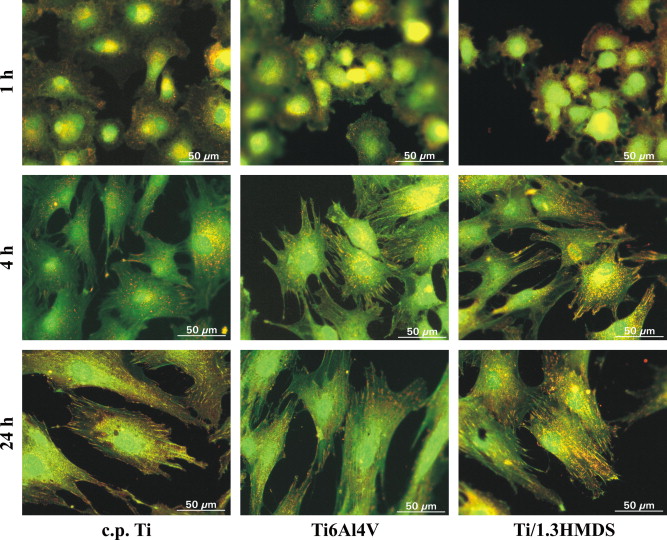A novel titanium-based material, containing no toxic or expensive alloying elements, was compared to the established biomaterials: commercially pure titanium (c.p. Ti) and Ti6Al4V. This material (Ti/1.3HMDS) featured similar hardness, yield strength and better wear resistance than Ti6Al4V, as well as better electrochemical properties at physiological pH 7.4 than c.p. Ti grade 1 of our study. These excellent properties were obtained by utilizing an alternative mechanism to produce a microstructure of very fine titanium silicides and carbides (<100 nm) embedded in an ultra-fine-grained Ti matrix (365 nm). The grain refinement was achieved by high-energy ball milling of Ti powder with 1.3 wt.% of hexamethyldisilane (HMDS). The powder was consolidated by spark plasma sintering at moderate temperatures of 700 °C. The microstructure was investigated by optical and scanning electron microscopy (SEM) and correlated to the mechanical properties. Fluorescence microscopy revealed good adhesion of human mesenchymal stem cells on Ti/1.3HMDS comparable to that on c.p. Ti or Ti6Al4V. Biochemical analysis of lactate dehydrogenase and specific alkaline phosphatase activities of osteogenically induced hMSC exhibited equal proliferation and differentiation rates in all three cases. Thus the new material Ti/1.3HMDS represents a promising alternative to the comparatively weak c.p. Ti and toxic elements containing Ti6Al4V.

A novel titanium-based material, containing no toxic or expensive alloying elements, was compared to the established biomaterials: commercially pure titanium (c.p. Ti) and Ti6Al4V. This material (Ti/1.3HMDS) featured similar hardness, yield strength and better wear resistance than Ti6Al4V, as well as better electrochemical properties at physiological pH 7.4 than c.p. Ti grade 1 of our study. These excellent properties were obtained by utilizing an alternative mechanism to produce a microstructure of very fine titanium silicides and carbides (<100 nm) embedded in an ultra-fine-grained Ti matrix (365 nm). The grain refinement was achieved by high-energy ball milling of Ti powder with 1.3 wt.% of hexamethyldisilane (HMDS). The powder was consolidated by spark plasma sintering at moderate temperatures of 700 °C. The microstructure was investigated by optical and scanning electron microscopy (SEM) and correlated to the mechanical properties. Fluorescence microscopy revealed good adhesion of human mesenchymal stem cells on Ti/1.3HMDS comparable to that on c.p. Ti or Ti6Al4V. Biochemical analysis of lactate dehydrogenase and specific alkaline phosphatase activities of osteogenically induced hMSC exhibited equal proliferation and differentiation rates in all three cases. Thus the new material Ti/1.3HMDS represents a promising alternative to the comparatively weak c.p. Ti and toxic elements containing Ti6Al4V.
